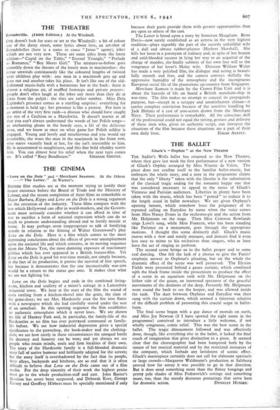THE BALLET
Gluck's " Orphee " at the New Theatre THE Sadler's Wells ballet has returned to the t4ew Theatre, where they gave last week the first performance of a new version of Gluck's Orphie arranged by Miss Ninette de Valois. The piece does not confine itself to the familiar ballet-music, but embraces the whole story, and a note in the programme claims that the only " liberty " taken with the libretto is the substitution of the classical tragic ending for the romantic happy one that was considered necessary to appeal to the tastes of Gluck's Viennese and Parisian audiences. Liberties in plenty have been taken with the music, which has been " potted " to reduce it to the length usual in ballet nowadays. We are given Orpheus's opening lament, which somehow loses the poignancy of its repeated calling on Eurydice by name when the voice comes from Miss Nancy Evans in the orchestra-pit and the action from Mr. Helpmann on the stage. Then Miss Ceinwen Rowlands sings Love's song, while Miss Fonteyn, who has been standing like Patience on a monument, goes through the appropriate motions. I thought this scene distinctly dull. Gluck's music moves with a slow and stately measure, and dancers find it even less easy to mime to his recitatives than singers, who at least have the act of singing to perform.
The second scene brings us to the ballet proper and to some real dancing. One felt the lack of a chorus to give the Furies' emphatic answer to Orpheus's pleading, but on the whole the dramatic effect of the scene was well preserved. The Elysian Fields were presented behind a gauze curtain; which combined wjth the black frame inside the proscenium to produce the effect of a scene in an aquarium tank with Mr. Helpmann on the hither side of the gauze, an interested spectator of the graceful movements of the denizens of the deep. Presently Mr. Helpmann went round the back to see the keeper, and was allowed inside the tank. The duet between Orpheus and Eurydice was then sung with the curtain down, which seemed a timorous solution of the difficult problem of presenting this crucial scene in ballet- form.
The final scene began with a gay dance of mortals on earth, and Miss Joy Newton (if I have spotted the right name in the programme) contrived to introduce a little welcome, if not wholly congruous, comic relief. This was the best scene in the ballet. The tragic denouement followed and was effectively done, though, like everything else in the ballet, it lacked the final touch of imagination that gives distinction to a piece. It seemed clear that the choreographer had been hampered both by the nature of her musical material and by the restricted resources of the company, which forbade any lavishness of scenic effect. Gluck's masterpiece certainly does not call for elaborate spectacle or large crowds—Margarete Waldmann's production at Salzburg proved how far astray it was possible to go in that direction. But it does need something more than the flimsy hangings and pretty pale shades of Miss Fedorovich's settings and something more, too, than the merely decorous posturings that serve here


























 Previous page
Previous page